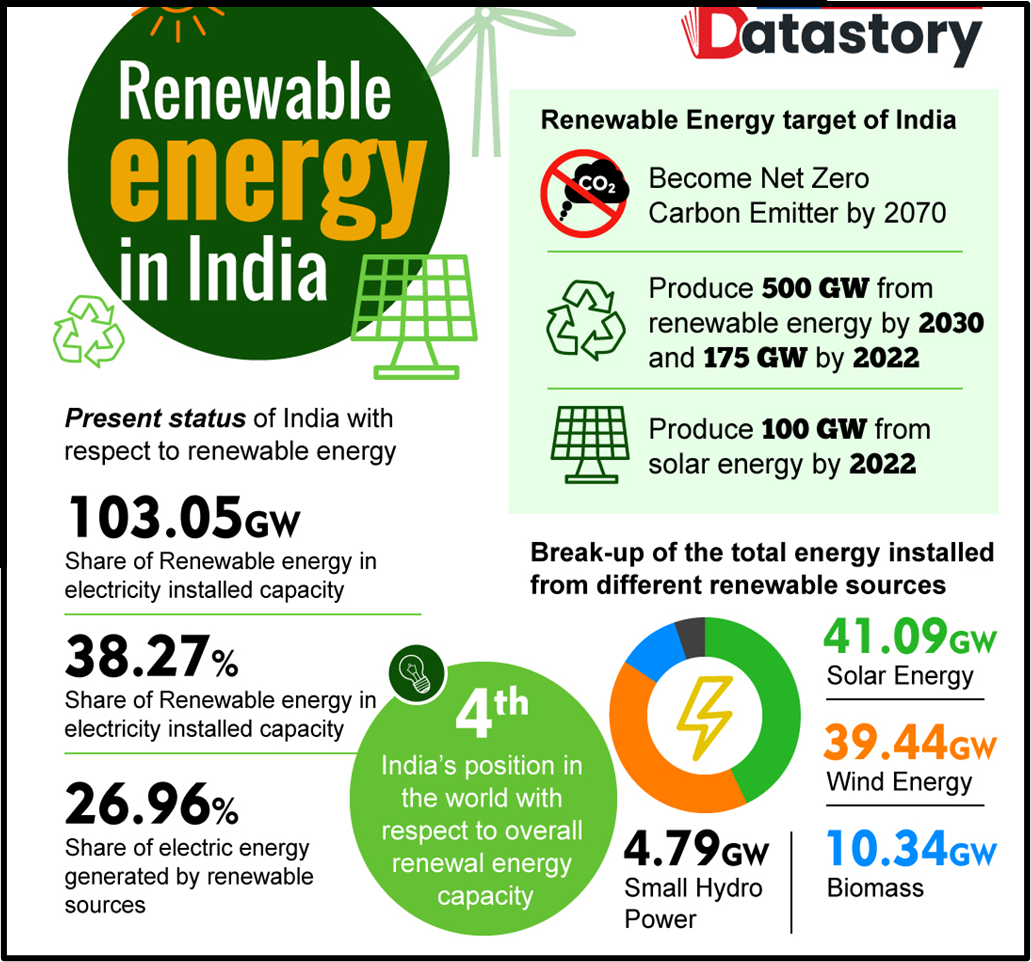HAVE RE WITHOUT THE HAVOC
Syllabus:
- GS-III: Conservation, Environmental Pollution and Degradation, Environmental Impact Assessment
- Infrastructure: Energy, Ports, Roads, Airports, Railways etc
Why in the news?
India’s green power revolution and its potential ecological impacts are highlighted in recent news discussions and debates.
source:slidserve
About Ensuring India’s Green Power Revolution Doesn’t Cause Ecological Damage
- India aims to draw half its energy from non-fossil fuel sources by 2030, driving a green power revolution.
- However, the rapid expansion of renewable energy threatens ecological harm if not managed properly.
Highlights of the Green Revolution in India:
- During the 1960s, India faced a severe food crisis, prompting collaboration between scientists likeS. Swaminathan and Norman Borlaug to develop high-yielding varieties of wheat and rice.
- The Green Revolution aimed to boost agricultural productivity and end the country’s reliance on grain imports.
| What is the Green Revolution?
● Introduction: The Green Revolution refers to a period of significant agricultural transformation in India during the 1960s and 1970s. ● Objective: The aim was to increase agricultural productivity and food grain production through the adoption of modern agricultural techniques and technologies. ● Key Features: ● Introduction of high-yielding varieties (HYVs) of seeds, particularly for wheat and rice. ● Increased use of chemical fertilisers, pesticides, and irrigation techniques. ● Adoption of modern farming practices and machinery to enhance efficiency and output. National Commission on Farmers (NCF): ● Formation: The National Commission on Farmers (NCF) was established in 2004 under the chairmanship of M.S. Swaminathan. ● Objective: NCF aimed to address the challenges faced by Indian farmers, including agrarian distress, land degradation, and lack of access to resources and markets What is Green Hydrogen? ● Green hydrogen is produced through electrolysis, utilising renewable energy sources such as wind or solar power. ● The process involves splitting water (H2O) into its constituent elements: hydrogen (H2) and oxygen (O2). ● It is called “green” because it is produced with zero greenhouse gas emissions, unlike traditional hydrogen production methods. Production Process: ● Electrolysis: Water is subjected to an electric current, causing it to separate into hydrogen and oxygen gases. ● Renewable Energy Source: Electricity used in electrolysis is generated from renewable sources like wind or solar power. ● Zero Emissions: Unlike conventional hydrogen production methods, green hydrogen production emits no greenhouse gases.. |
Understanding the Renewable Energy:
- Energy produced from natural processes and continuously replenished.
- Examples include sunlight, water, wind, tides, geothermal heat, and biomass.
- Used in areas such as air and water cooling/heating, electricity generation, rural sector, and transportation.
Sources of Renewable Energy:
- Sustainable sources: biomass, nuclear power, geothermal, wind energy, solar power, tidal power, and wave power.
- Spread over a wide geographical area, unlike conventional resources concentrated in a few countries.
- Less pollution, significant economic benefits, and improved energy security.
About the Types of Renewable Energy:
- Solar Energy: Utilises various types of solar collectors like photovoltaics and solar heating.
- Wind Energy: Modern wind turbines range from 600 Kilowatt to 5 Megawatts, generating electricity from natural airflow.
- Hydroelectricity: Generated by harnessing kinetic energy from flowing water, including tidal power and wave power.
- Geothermal Energy: Uses heat energy from the earth’s interior, often from hot springs and volcanoes.
- Biomass Energy: Derived from biological materials, can be used directly for heat or converted into biofuels like ethanol and biodiesel.
About Separating Renewable Energy Production from Storage:
- Current practices burden green entrepreneurs with locating and building pumped storage sites.
- Role of Hydrogen in Energy Storage:
- Hydrogen can be transported and stored efficiently, offering a flexible and scalable solution for renewable energy storage.
- Collaboration between public and private sectors can accelerate the development and deployment of green hydrogen infrastructure.
- Environmental Considerations in Renewable Energy Expansion:
- Balancing renewable energy expansion with ecological preservation is crucial.
- Avoiding deforestation, habitat destruction, and ecological disruption is essential for sustainable energy development.
- Comprehensive environmental impact assessments and mitigation measures should be integrated into renewable energy projects.
- Benefits of Sustainable Energy Practices:
- Adoption of environmentally friendly energy storage solutions can enhance India’s global leadership in renewable energy.
- Promoting sustainable energy practices aligns with India’s commitments to combat climate change and protect biodiversity.
- Collaboration between stakeholders can drive innovation and ensure the long-term sustainability of India’s green energy revolution..
Challenges:
- Challenges of Pumped Storage Hydroelectric Projects:
- Pumped storage projects involve submerging land and building dams, causing ecological disruption.
- Implementing large-scale pumped storage projects across multiple locations requires substantial time, resources, and environmental clearances.
- Alternative strategies are needed to minimise ecological damage while enhancing energy storage capacity.
- Challenges and Opportunities in Green Hydrogen Adoption:
- High initial investment and infrastructure costs are key challenges.
- Leveraging India’s existing wind and solar capacity can facilitate the transition to green hydrogen.
- Policy support and regulatory frameworks are essential to incentivize investment and promote innovation in green hydrogen technology
Way Forward:
- Innovative Solutions:
- Adoption of green hydrogen as an energy storage solution.
- Green hydrogen can be produced using surplus renewable energy and stored without carbon emissions.
- It offers a viable alternative to batteries, which may lead to ecological disasters due to mining and deforestation.
- Ideal solution: Separate renewable energy production from storage and assign hydel specialists to build pumped storage capacity in environmentally benign ways.
- Urgent policy intervention needed to implement this approach effectively.
Conclusion:
Ensuring India’s green power revolution does not cause ecological damage requires innovative solutions and proactive policy interventions.By prioritising environmentally friendly energy storage options like green hydrogen and integrating environmental considerations into renewable energy projects, India can achieve its energy goals while safeguarding its natural ecosystems for future generations.
Source: The Economic Times
Mains Practice Question:
Discuss the environmental implications of India’s renewable energy ambitions and propose strategies to ensure sustainable and eco-friendly development in the renewable energy sector.




